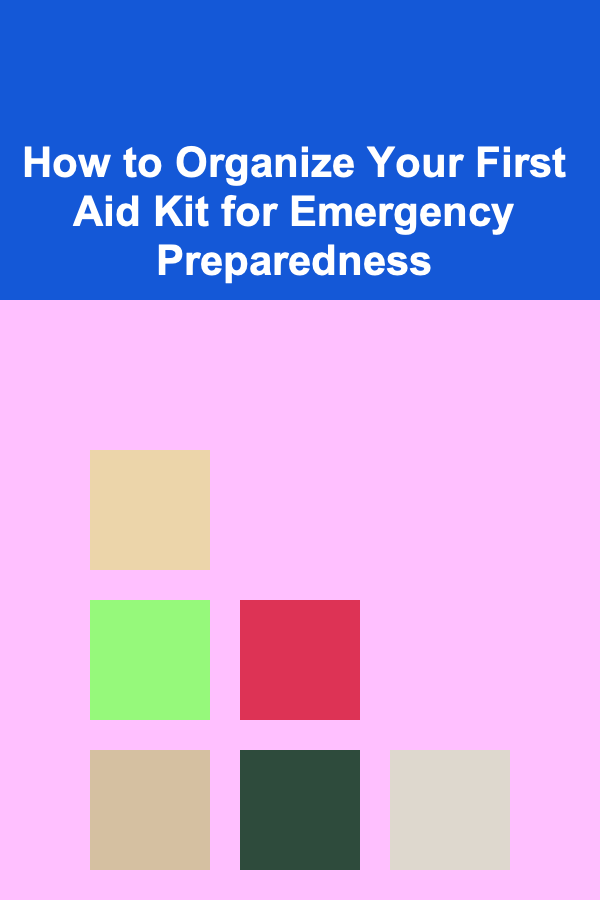
How to Organize Your First Aid Kit for Emergency Preparedness
ebook include PDF & Audio bundle (Micro Guide)
$12.99$5.99
Limited Time Offer! Order within the next:

Emergencies can happen at any time, and being prepared is crucial. A well-organized first aid kit is a fundamental component of any preparedness plan, whether at home, in the car, or while traveling. Having the right supplies readily available can make a significant difference during critical moments when every second counts.
In this comprehensive guide, we will explore how to effectively organize your first aid kit for emergency preparedness. We will cover essential items to include, techniques for organization, tips for maintenance, and guidelines for specific situations. By the end of this article, you will have a thorough understanding of how to create and maintain an efficient first aid kit that meets your needs.
Understanding the Importance of a Well-Organized First Aid Kit
1. Quick Access in Emergencies
In a crisis, locating the right supplies quickly can be vital. A well-organized first aid kit ensures that necessary items are easy to find, saving precious time.
2. Comprehensive Preparedness
A properly stocked first aid kit prepares you for various emergencies---from minor cuts and bruises to more serious injuries or illnesses. This preparedness can provide peace of mind for you and your loved ones.
3. Enhanced Safety
Having a first aid kit equipped with essential items can help prevent infections and complications that can arise from untreated injuries. It empowers you to administer immediate care when needed.
4. Confidence Boost
Knowing that you have the tools and supplies to handle minor medical issues fosters confidence, allowing you to react calmly in emergencies.
5. Easier Maintenance
An organized first aid kit is easier to inspect and replenish. Regular checks ensure that all items are up-to-date and usable.
Essential Components of a First Aid Kit
Before organizing your first aid kit, it's crucial to understand what items it should contain. Here's a comprehensive list of essential components:
1. Basic Supplies
- Adhesive Bandages: Various sizes for small cuts and abrasions.
- Gauze Pads: For larger wounds; use with adhesive tape.
- Adhesive Tape: To secure gauze pads and dressings.
- Sterile Gloves: To protect both the caregiver and the patient.
- Scissors: For cutting tape, gauze, or clothing if necessary.
- Tweezers: For removing splinters or debris.
2. Antiseptics and Antibiotics
- Antiseptic Wipes: For disinfecting skin before applying bandages.
- Hydrogen Peroxide: For cleaning wounds (use cautiously).
- Antibiotic Ointment: To apply on cuts to prevent infection.
3. Pain Relief and Medication
- Pain Relievers: Ibuprofen, acetaminophen, or aspirin (be cautious with aspirin in children).
- Allergy Medication: Antihistamines like diphenhydramine for allergic reactions.
- Anti-Nausea Medication: Such as meclizine for motion sickness.
4. Emergency Supplies
- Instant Cold Packs: For reducing swelling and pain.
- Thermometer: For checking body temperature.
- CPR Face Shield: For administering CPR safely if needed.
- Burn Dressings: Specifically designed for treating burns.
5. Specialty Items
Depending on your household needs, consider including:
- Epinephrine Auto-Injector: For severe allergic reactions (anaphylaxis).
- Emergency Blanket: To retain body heat in shock or hypothermia cases.
- Snake Bite Kit: If you live in an area prone to snake bites.
6. Personal Medications and Documents
- Personal Medications: Include any prescription medications or chronic condition supplies (e.g., inhalers, insulin).
- Medical Information Cards: List any allergies, medical conditions, and medications for quick reference.
Choosing the Right Container
1. Size Matters
Select a container that fits your storage space and holds all essential items without being cramped. Consider a hard-shell case for durability or a soft bag for portability.
2. Compartments and Organization
Choose a container with compartments or pockets to keep supplies organized. Look for options with clear zippered pouches for visibility.
3. Labeling
Label each compartment or pouch clearly so that you can find items quickly. Use a label maker or write on the bags with a permanent marker.
Steps for Organizing Your First Aid Kit
Step 1: Gather Supplies
Collect all the essential items listed above. Have them ready in one place before beginning the organization process.
Step 2: Sort Items
Group items by category:
- Wound Care (bandages, ointments)
- Medications (pain relievers, allergy meds)
- Emergency Supplies (cold packs, thermometers)
Step 3: Evaluate Expiration Dates
Check the expiration dates on medications and ointments. Discard any expired items and make a note to replace them.
Step 4: Arrange Items in the Container
Place similar items together in the designated compartments or pouches. Ensure that frequently used items are easily accessible.
- Top Section: Keep quick-access items such as band-aids and antiseptic wipes.
- Middle Section: Store larger items like gauze pads and emergency blankets.
- Bottom Section: Reserve for less frequently used items like specialty tools or documents.
Step 5: Close and Secure the Kit
Ensure that the container shuts securely and is portable if necessary. Keep the kit in a location that is easily accessible in an emergency.
Customizing Your First Aid Kit
1. Family Needs
Consider the specific needs of your family members when customizing your first aid kit:
- Children: Include pediatric doses and child-friendly supplies.
- Elderly: Add items for common age-related issues, like arthritis cream or adult diapers.
- Pets: Create a separate pet first aid kit with supplies tailored for animal care.
2. Travel Considerations
If you travel often, customize a travel first aid kit with supplies suited for typical travel-related issues, such as:
- Motion Sickness: Include anti-nausea medication.
- Sunburn: Pack aloe vera lotion or burn relief gel.
- Insect Bites: Carry bite relief cream or antihistamine.
3. Outdoor Activities
For outdoor enthusiasts or hikers, incorporate additional supplies like:
- Multi-tool: Incorporates various tools into one handy item.
- Splints: For immobilizing injured limbs during outdoor adventures.
Maintenance of Your First Aid Kit
1. Regular Inspections
Schedule regular inspections of your first aid kit---ideally every six months. Check for:
- Expired items
- Broken or unusable supplies
- Missing items
2. Restock Items
Restock any supplies that have been used or that have expired. Make it a habit to check after major events (e.g., holidays, vacations) when you might have used supplies.
3. Stay Updated on Medical Guidelines
Keep abreast of changes in medical recommendations regarding first aid practices. Adjust your kit accordingly to reflect updated information.
4. Educate Yourself
Educate yourself and your family on basic first aid procedures. Familiarize everyone with the contents of the kit and how to use each item effectively.
First Aid Resources
1. First Aid Manuals
Include a pocket-sized first aid manual in your kit. This can provide quick guidance during emergencies.
2. Online Resources
Bookmark reliable online resources or apps that offer first aid instructions. The American Red Cross and other organizations provide excellent resources.
3. Local Classes
Consider enrolling in a first aid and CPR class offered by local community centers or organizations. Hands-on training can significantly enhance your readiness.
Specific Situations and Tailored Kits
1. Home Preparedness
Your primary home first aid kit should be comprehensive but also tailored to the unique risks of your household. Consider:
- Emergency plans for natural disasters (earthquakes, floods).
- Supplies for managing chronic conditions within the family.
2. Vehicle First Aid Kit
When organizing a vehicle first aid kit, focus on essentials that cater to common roadside emergencies:
- Reflective Triangle: For signaling distress.
- Flashlight with Extra Batteries: For nighttime emergencies.
- Basic Tool Kit: For minor car repairs.
3. Workplace First Aid Kit
If you're responsible for workplace safety, ensure your first aid kit complies with occupational safety regulations:
- Include items for workplace-specific hazards (gloves, eye wash).
- Ensure accessibility for all employees.
4. Travel First Aid Kit
Create a compact travel first aid kit that fits easily in a suitcase or backpack. Focus on lightweight items that address potential travel-related issues:
- Travel-Sized Toiletries: Including antiseptics and ointments.
- Miniature Medications: For headaches, allergies, or stomach issues.
Conclusion
Organizing your first aid kit for emergency preparedness is not just a task; it's an investment in safety and peace of mind. By understanding the essential components, creating an effective organizational system, and maintaining your kit regularly, you can ensure that you are ready to handle a variety of situations.
Preparedness extends beyond merely assembling supplies---it requires continuous education, routine maintenance, and a willingness to adapt your kit to meet changing needs. Embrace the responsibility of being prepared, knowing that your efforts contribute to the well-being of yourself and your loved ones. With a well-organized first aid kit at hand, you'll face emergencies with confidence and clarity, ready to respond effectively when it matters most.
Reading More From Our Other Websites
- [Organization Tip 101] How to Organize Kitchen Essentials in a Rental Property
- [Weaving Tip 101] Weaving Your Second Chapter: Creative Techniques for Reinventing Yourself
- [Home Space Saving 101] How to Create a Functional Workspace with a Desk with Built-in Storage
- [Home Maintenance 101] How to Choose the Right Products for Home Maintenance
- [Organization Tip 101] Best Time‑Blocking & Task Management Systems for Peak Personal Organization
- [Organization Tip 101] How to Use Hooks and Racks for Gym Bag Storage
- [Digital Decluttering Tip 101] The Digital Declutter Checklist: Streamline Apps, Notifications, and Storage
- [Soap Making Tip 101] Creative Recipes: Adding Scents and Colors to Shea Butter Soap
- [Home Budget Decorating 101] How to Create a Low-Cost Living Room: Affordable Ideas for a Cozy Space
- [Home Holiday Decoration 101] How to Make Your Own Holiday Gift Wrap

How to Implement a Budgeting System for Seniors
Read More
How to Implement Blockchain in Your Business: A Comprehensive Guide
Read More10 Tips for Maximizing Health Insurance Expense Tracking
Read More
How to Plan a Solo Female Travel to-Do List
Read More
How to Build a Custom Mountain Bike Wheelset
Read More
10 Strategies for Dealing with Social Security Disability Case Delays
Read MoreOther Products

How to Implement a Budgeting System for Seniors
Read More
How to Implement Blockchain in Your Business: A Comprehensive Guide
Read More10 Tips for Maximizing Health Insurance Expense Tracking
Read More
How to Plan a Solo Female Travel to-Do List
Read More
How to Build a Custom Mountain Bike Wheelset
Read More